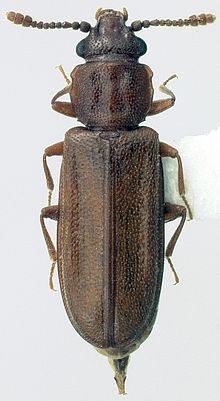Cucujidae
| Cucujidae Temporal range:
| |
|---|---|

| |
| Cucujus cocccinatus | |
| Scientific classification | |
| Domain: | Eukaryota |
| Kingdom: | Animalia |
| Phylum: | Arthropoda |
| Class: | Insecta |
| Order: | Coleoptera |
| Suborder: | Polyphaga |
| Infraorder: | Cucujiformia |
| Superfamily: | Cucujoidea |
| Family: | Cucujidae Latreille, 1802 |
| Genera | |
The Cucujidae, or flat bark beetles, are a family of distinctively flat beetles found worldwide (except Africa and Antarctica) under the bark of dead trees. The family has received considerable taxonomic attention in recent years and now consists of 70 species distributed in five genera.[1][2][3][4][5][6] It was indicated Cucujus species are scavengers, only feeding on pupae and larvae of other insects and on other subcortical beetles such as their own. Since the Cucujidae prey on larvae of potentially tree damaging beetles that spread fungal diseases, they are considered to be beneficial to the health of living trees.[7]

Included genera are: Cucujus Fabricius, with 14 species and subspecies distributed throughout the Holarctic; Palaestes Perty, 8 spp., Neotropical; Pediacus Shuckard, 31 spp., mostly Holarctic, but extending south into the Neotropics and to Australia; Platisus Erichson, 5 spp. in Australia and New Zealand, and Thesaurus known from South America.

Cucujidae have elongate parallel-side bodies ranging from 6 to 25 mm in length. Most are brown colored, while others are black, reddish or yellow. Heads are triangular in shape, with filiform to moniliform antennae of 11 antennomeres, and large mandibles. The pronotum is narrower than the head.[8][9]

Both larvae and adults live under bark, otherwise little is known of their habits.[10][11] Larvae and adults appear to be predacious.[10][11] Cucujus cinnaberinus seems to be able to colonize isolated habitats from persisting local populations if there is a sufficient quantity of suitable deadwood in the habitat and it has the other requirements of saproxylic beetles.[12]
The family was formerly larger, with subfamilies Laemophloeinae, Silvaninae, and Passandrinae (and some tenebrionoid genera mixed in), but revisions have raised the subfamilies to family status.[8]
While there have been claimed fossil records going back to the Early Cretaceous (such as those from the Crato Formation of Brazil), the oldest unambiguous records are from the Eocene.[11]
Species with extreme freezing tolerance
[edit]Cucujus clavipes puniceus (red flat bark beetle) found in arctic regions like Canada and Alaska [13] desiccates to 30–40% body water in winter vs 4% body water in the chironomid fly, Polypedilum vanderplanki. It uses a variety of anti-freeze proteins[14][15] in contrast with the non-protein xylomannan exploited by another arctic beetle Upis ceramboides.[13]
References
[edit]- ^ C. F. Lee and A. Pütz. (2008) A new species of Cucujus Fabricius, 1775 from China and key to the east–Palaearctic species of the genus (Coleoptera: Cucujidae). Entomologische Zeitschrift 118 (5): 211–213.
- ^ C. F. Lee and M. Satô. (2007) A Review of the Genus Cucujus Fabricius (Insecta: Cucujoidea: Cucujidae) from Taiwan, Japan, and China, with Descriptions of Two New Species and the Larvae of Cucujus mniszechi Grouvelle. Zoological Studies 46: 311–321.
- ^ Teresa Bonacci, Antonio Mazzei, Jakub Horákand, and Pietro Brandmayr. 2012. Cucujus tulliae sp. n. – an endemic Mediterranean saproxylic beetle from genus Cucujus Fabricius, 1775 (Coleoptera, Cucujidae), and keys for identification of adults and larvae native to Europe. Zookeys. 2012; (212): 63–79.
- ^ John W. M. Marris and Adam Ślipiński. 2014. A revision of the Pediacus Shuckard 1839 (Coleoptera: Cucujidae) of Asia and Australasia. Zootaxa 3754(1): 32–58.
- ^ Michael C. Thomas. 2004. A revision of Pediacus Shuckard (Coleoptera: Cucujidae) for America north of Mexico, with notes on other species. Insecta Mundi 17: 157–177 (2003).
- ^ J. C. Watt, J. W. M. Marris and J. Klimazsewski. 2001. A new species of Platisus (Coleoptera: Cucujidae) from New Zealand, described from the adult and larva. Journal of the Royal Society of New Zealand, 31: 327–339.
- ^ Bonacci, T., Mazzei, A., Naccarato, A., Elliani, R., Tagarelli, A., & Brandmayr, P. (2018). Beetles “IN red”: Are the ENDANGERED FLAT bark beetles CUCUJUS Cinnaberinus and c. Haematodes Chemically protected? (coleoptera: Cucujidae). The European Zoological Journal, 85(1), 128–136. doi:10.1080/24750263.2018.1449906
- ^ a b Michael C. Thomas (2002). "Family 82. Cucujidae Latreille 1802. Pp. 329–330". In Ross H. Arnett Jr.; Michael C. Thomas; Paul E. Skelley; J. H. Frank (eds.). American Beetles. Vol. 2. Polyphaga: Scarabaeoidea through Curculionoidea. CRC Press, Boca Raton. pp. xiv + 861.
- ^ Michael C. Thomas and R.A.B. Leschen. 2010. Cucujidae Latreille, 1802. p. 350–354. In: Leschen, R.A.B., R.G. Beutel, and J.F. Lawrence. Coleoptera, Beetles. Vol. 2: Morphology and Systematics (Elateroidea, Bostrichiformia, Cucujiformia partim). Handbook of Zoology. Walter de Gruyter, Berlin.
- ^ a b D. B. Smith and M. K. Sears. 1982. Mandibular structure and feeding habits of three morphologically similar coleopterous larvae: Cucujus clavipes (Cucujidae), Dendroides canadensis (Pyrochroidae), and Pytho depressus (Salpingidae). Canadian Entomologist 114: 173–175.
- ^ a b c Jin, Mengjie; Zwick, Andreas; Ślipiński, Adam; Marris, John W. M.; Thomas, Michael C.; Pang, Hong (April 2020). "A comprehensive phylogeny of flat bark beetles (Coleoptera: Cucujidae) with a revised classification and a new South American genus". Systematic Entomology. 45 (2): 248–268. doi:10.1111/syen.12392. ISSN 0307-6970. S2CID 216193827.
- ^ HORAK, J., VAVROVA, E., & CHOBOT, K. (2010). Habitat preferences Influencing POPULATIONS, distribution and conservation of the Endangered Saproxylic beetle CUCUJUS cinnaberinus (coleoptera: Cucujidae) at the landscape level. European Journal of Entomology, 107(1), 81–88. doi:10.14411/eje.2010.011
- ^ a b Ned Rozell (Oct 2007). "Alaska beetles survive 'unearthly' temperatures".
- ^ Carrasco MA, Buechler SA, Arnold RJ, Sformo T, Barnes BM, Duman JG (Feb 2012). "Investigating the deep supercooling ability of an Alaskan beetle, Cucujus clavipes puniceus, via high throughput proteomics". J Proteomics. 75 (4): 1220–34. doi:10.1016/j.jprot.2011.10.034. PMID 22094879.
- ^ Sformo T, Walters K, Jeannet K, Wowk B, Fahy GM, Barnes BM, Duman JG (Feb 1, 2010). "Deep supercooling, vitrification and limited survival to −100{degrees}C in the Alaskan beetle Cucujus clavipes puniceus (Coleoptera: Cucujidae) larvae". J Exp Biol. 213 (3): 502–9. doi:10.1242/jeb.035758. PMID 20086136.
